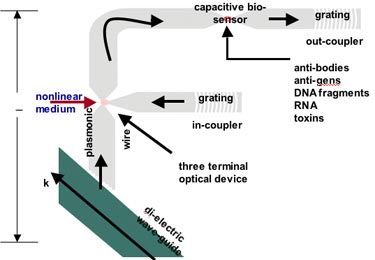Plasmon Optics Will Open a New Domain for Integrated Photonics based on:
 Extreme light localization: nonlinear excitations in ultrasmall volumes ‡ compact low-power all-optical devices Extreme light localization: nonlinear excitations in ultrasmall volumes ‡ compact low-power all-optical devices- Very high spatial frequencies: opportunity for optical imaging systems with nm-scale resolution
- Enhanced light-emission from active photonic devices via coupling to surface plasmons
- Coupling from dielectric (fiber and SOI waveguide-based) photonics to plasmonic devices.
Innovative Claims and Expected Outcomes:
- Investigate design and application of surface plasmon photonic crystal quantum cascade lasers for spectroscopy and near-field microscopy.
- Demonstrate surface plasmon-enhanced light emission and quantum efficiency from GaN, Si nanocrystals and Er-doped Si LEDs.
- Investigate electro-optic, all-optical and piezoelectric modulation of subwavelength plasmon waveguide transmission.
- Explore the physics of very high electric fields in tiny optical frequency capacitors, and will investigate use of this ultra-nonlinear physics to create of a practical all-optical three-terminal switching device.
- Create the first optical frequency metallic wired circuits.
- Explore design and fabrication of negative index and artificial magnetic plasmonic materials
- Develop two-dimensional plasmon optical components, including lenses and grating couplers that couple single mode fiber directly to plasmonic circuits and will investigate the performance of an imaging system comprised of these components.
- Determine the maximum optical electric field that can be achieved in plasmonic devices, and the highest change in nonlinear dielectric constant that can be achieved
- Develop combined lithography and self-assembly methods for defining metallic nanostructures useful for in-situ spectroscopy and imaging.
|


 Extreme light localization: nonlinear excitations in ultrasmall volumes ‡ compact low-power all-optical devices
Extreme light localization: nonlinear excitations in ultrasmall volumes ‡ compact low-power all-optical devices